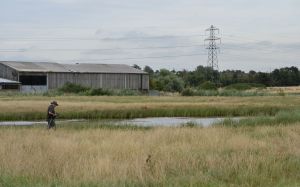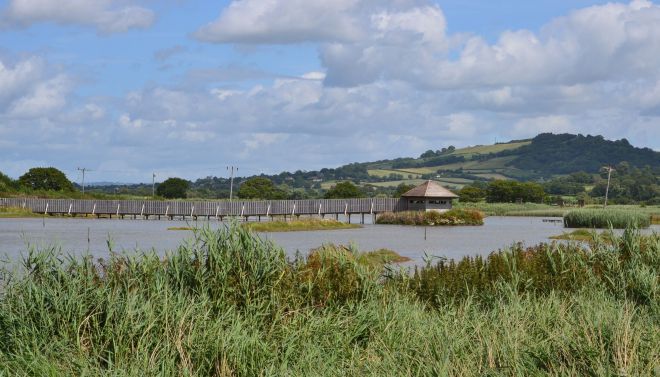As of 2015 I had observed every regularly occurring English damselfly but one, the exception being Scarce Emerald. So my top Odonata priority this season has been to complete the full set, and mid-August is the time to do it. One well-known site for the final species is RSPB Bowers Marsh on the Thames estuary in Essex, and with no birding lifers to take precedence this week that was where I headed yesterday.
My task was simplified because Adam visited here a week earlier having gained directions from an online contact as to the exact location to find these insects. Arriving late on a lightly overcast morning I met another naturalist, Mike Barnett from Basingstoke, in the car park (TQ755867) and he was on the same mission as myself. Setting off together and after a quick phone call to Adam to verify the correct place to look, we arrived at a small and shallow, reed-filled pool that is prime habitat for our target.
It didn’t take long to find three male Emerald sp damselflies mooching about and perching on stems, usually with wings half open. Two local patch watchers then joined in and assured us these were indeed Scarce Emerald. In the pictures below I have arranged three individuals in what I believe is ascending order of maturity, if that makes sense. The brown-toned left-hand insect is the least mature, while the right-hand one is I hope a fully mature male though I’m not entirely sure of which type.
Having read up on the species again in Brooks and Lewington, I feel confident enough to publish them. That odo bible quotes four diagnostics, since Scarce Emerald is very similar to Common Emerald, and for the key one we are talking anal appendages. The inferior AA’s, or the inner bits of his bits to you and I, are broader and more curved in Scarce than Common, and this is quite apparent in the left-hand picture.
Turned off completely? Well it gets less goolie-ish from now on. Brooks and Lewington lists more “subtle differences” that I believe are apparent in my none too sharp pictures:
- squarer shape of the pterostigma (black wing tags)
- less extensive blue colouration on abdominal segment 2, that is absent in the left-hand immature male but shows well in the right-hand image
- brighter blue colour of the eyes, and aren’t they just!?
A return visit to this site next year could well be in order to remove all doubt. I am used to encountering a lot of colour variation in Emerald damselflies at different stages of their life cycle, and today was no exception. We found no female Scarce Emerald at Bowers Marsh, unfortunately.

Another part of Bowers Marsh
So now I have observed the complete sets of regularly occurring English dragonflies and damselflies, but still require both sightings and images of some females and immatures. Things will be largely about photography again next season, and believe me I have spent a certain amount of time attempting to improve on past results this summer, mostly without success. Three afternoons watching Brilliant Emerald dragonflies at Warren Heath, Hants was one un-blogged example.
But insect observation cannot be rushed, like zapping in and out on an adrenalin rush to twitch a rare bird. This is where I feel bored birders dabbling with insects in June and July sometimes get it wrong, with respect. A chair, my camera and solitude in wild places is the appeal of odonata for me, and continuous improvement in recording visually the experiences they offer remains the quest.






